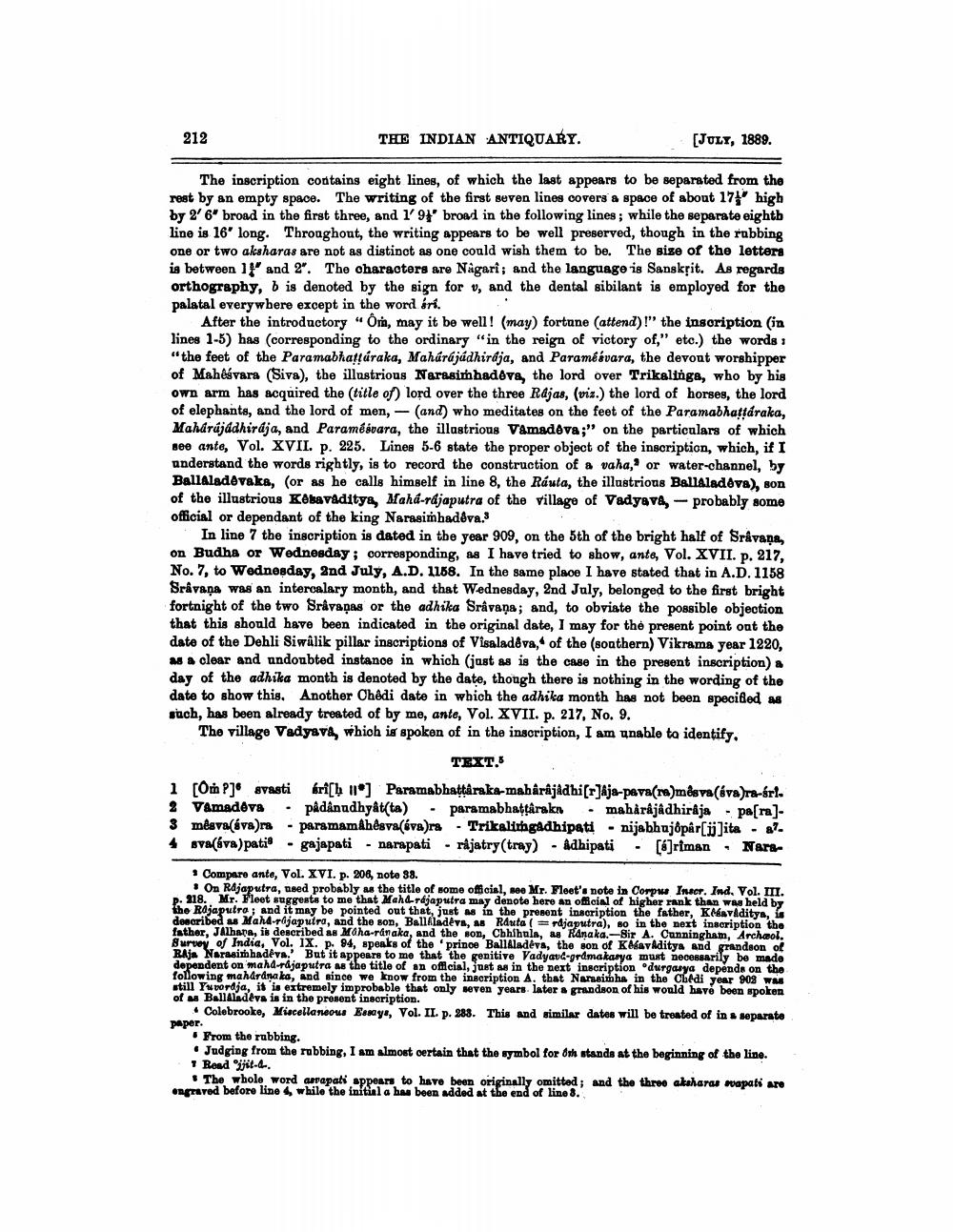________________
212
THE INDIAN ANTIQUARY.
[JULY, 1889.
The inscription contains eight lines, of which the last appears to be separated from the rest by an empty space. The writing of the first seven lines covers a space of about 17 high by 2' 6broad in the first three, and 1 91 broad in the following lines; while the separate eighth line is 16" long. Throughout the writing appears to be well preserved, though in the rubbing one or two aksharas are not as distinct as one could wish them to be. The size of the letters is between 1 and 2". The characters are Nagari; and the language is Sanskrit. As regards orthography, bis denoted by the sign for v, and the dental sibilant is employed for the palatal everywhere except in the word bri.
After the introductory "Öm, may it be well! (may) fortane (attend) !" the inscription in lines 1-5) has (corresponding to the ordinary "in the reign of victory of," etc.) the words: "the feet of the Paramabhattáraka, Mahúrájádhiraja, and Paramésvara, the devout worshipper of Mahéávara (Siva), the illustrious Narasimhadeva, the lord over Trikalinga, who by his own arm has acquired the title of) lord over the three Rajas, (viz.) the lord of horses, the lord of elephants, and the lord of men, - (and) who meditates on the feet of the Paramabhattáraka, Maharájádhirdja, and Param&svara, the illastrious Vamadeva;" on the particulars of which see ante, Vol. XVII. p. 225. Lines 5-6 state the proper object of the inscription, which, if I understand the words rightly, is to record the construction of a vaha, or water-channel, by BallAladdvaka, (or as he calls himself in line 8, the Rauta, the illustrious BallAladdva), son of the illustrious Keavaditya, Mahd-rájaputra of the village of Vadyava, - probably some official or dependant of the king Narasimhadeva.
In line 7 the inscription is dated in the year 909, on the 5th of the bright half of Sråvaņa, on Budha or Wednesday ; corresponding, as I have tried to show, ante, Vol. XVII. p. 217, No. 7, to Wednesday, and July, A.D. 1158. In the same place I have stated that in A.D. 1158 Sråvana was an intercalary month, and that Wednesday, 2nd July, belonged to the first bright fortnight of the two Sråvaņas or the adhika Sråvaņa; and, to obviate the possible objection that this should have been indicated in the original date, I may for the present point out the date of the Dehli Siwalik pillar inscriptions of Visaladeva, of the southern) Vikrama year 1220, as a clear and undoubted instance in which (just as is the case in the present inscription) a day of the adhika month is denoted by the date, though there is nothing in the wording of the date to show this. Another Chedi date in which the adhika month has not been specified as such, has been already treated of by me, ante, Vol. XVII. p. 217, No. 9.
The village Vadyava, which is spoken of in the inscription, I am unable to identify
TEXT:
1 [OR P]" svastikrich 11] Paramabhattaraka-maharajadhi[r]Aja-pava(ra)megva(áva)ra-srl. 2 Vamadova • pådanudhyât(ta) . paramabhattarakh . mahårâjâdhiraja - para)3 mêsva(sva)ra - paramamahdsva(svara - Trikalingadhipati - nijabhajópár[i]ita - a7. 4 sva(áva)pati - gajapati - narapati - råjatry(tray) - Adhipati . [6]riman - Nars
• Compare ante, Vol. XVI. p. 206, note 88.
On Rajaputra, need probably as the title of some official, see Mr. Fleet's note in Corpw Inscr. Ind. Vol. III. p. 318. Mr. Fleet suggests to me that Maharajaputra may denote here an official of higher rank than was held by the Rajaputro and it may be pointed out that, just as in the present inscription the father, Klaviditys, is dowcribed as Mahd-rijaputra, and the son, Ballfladeva, as Rauta (srdjaputra), so in the next inscription the father, JAlhana, is described as Maha-ranaka, and the son, Chhihula, as Kanaka.- Sir A. Cunningham, Archeol. Survey of India, Vol. IX. p. 94, speaks of the prince BallAladeva, the son of Kesav Aditya and grandson of Raja Narasimhadeva.' But it appears to me that the genitive Vadyavd-grdmakarya must necessarily be made dependent on mahd-rajaputra as the title of an official, just as in the next inscription durganya depends on the following mahardna ko, and since we know from the inscription A. that Narasimha in the Chedi year 903 was still Yw wordja, it is extremely improbable that only seven years later & krundson of his would have been spoken of a BallAladeva is in the present inscription.
* Colebrooke, Miscellaneous Essays, Vol. II. p. 283. This and similar dates will be treated of in separate paper.
. From the rubbing. • Judging from the rubbing, I am almost certain that the symbol for Orh stands at the beginning of the line. * Read fit-4.
• The whole word aprapat appears to have been originally omitted; and the three akaharas wapats are engraved before line 4, while the initiala has been added at the end of line 8.'




